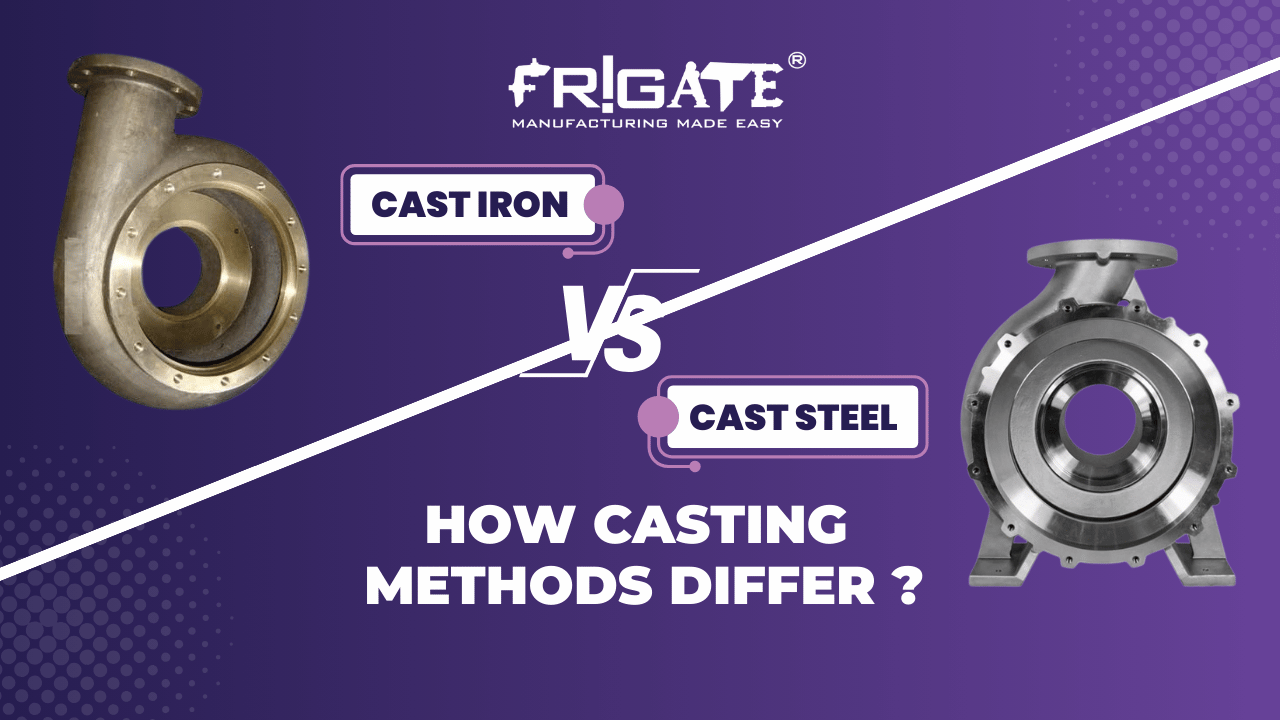Choosing the right material for your industrial project is crucial. When it comes to creating complex shapes, cast iron and cast steel are two popular options. Both offer unique advantages and disadvantages, making the selection process dependent on your specific needs. Let’s delve into the world of cast iron vs. cast steel, exploring their properties, strengths, weaknesses, and ideal applications.

Cast Iron
Cast iron is a type of cast iron containing a higher carbon content (more than 2%) compared to steel. This elevated carbon content significantly impacts its properties. Here’s a closer look at some key characteristics of cast iron-
- Compressive Strength- Cast iron excels in compressive strength, making it highly resistant to crushing forces. This property makes it perfect for applications that experience constant pressure, such as engine blocks and machine tool bases.
- Brittleness- Due to the high carbon content, cast iron is brittle. It can withstand compression but struggles under tension or impact, meaning it can crack or shatter easily.
- Machinability- Cast iron is generally easier to machine compared to cast steel. The graphite flakes in the iron act as natural lubricants, reducing friction during machining processes.
- Wear Resistance- Certain types of cast iron, particularly grey cast iron, exhibit excellent wear resistance. The graphite flakes act as a solid lubricant, making them ideal for applications that involve friction, such as brake drums and cylinder liners.
There are various types of cast iron, each with its own properties. Some of the most common varieties include-
- Grey Cast Iron- The most widely used cast iron, known for its good machinability, wear resistance, and vibration-dampening properties.
- Ductile Iron (Nodular Iron)- Offers superior strength and ductility compared to grey cast iron. It’s less brittle and can withstand impact better.
- Malleable Iron- Goes through a heat treatment process that transforms the graphite flakes into nodules, enhancing its ductility and toughness.
Cast Steel
Cast steel, on the other hand, boasts a lower carbon content (less than 2%) compared to cast iron. This difference significantly alters its properties-
- Tensile Strength- Cast steel excels in tensile strength, allowing it to bend under pressure without breaking. This makes it suitable for applications that experience pulling or stretching forces, such as beams, gears, and crankshafts.
- Ductility and Toughness- Cast steel is generally more ductile and tougher than cast iron. It can deform under stress without cracking, making it more versatile for various applications.
- Castability- Cast steel can be slightly more challenging to cast compared to cast iron due to its higher melting point and lower fluidity. However, advancements in casting techniques have minimized this difference.
- Weldability- Cast steel offers superior weldability compared to cast iron. This allows for easier fabrication and repairs.
Similarities and Key Differences
While both cast iron and cast steel are metals formed through casting processes, several key distinctions set them apart. Here’s a quick comparison table highlighting the critical differences between cast iron vs. cast steel
| Feature | Cast Iron | Cast Steel |
| Carbon Content | High (more than 2%) | Low (less than 2%) |
| Compressive Strength | High | Moderate |
| Tensile Strength | Low | High |
| Brittleness | High | Low |
| Machinability | Good | Fair |
| Wear Resistance | Excellent (depending on type) | Moderate |
| Castability | Easy | More challenging |
| Weldability | Poor | Good |
Applications for Cast Iron and Cast Steel
The choice between cast iron and cast steel depends on the specific needs of your project. Here’s a breakdown of ideal applications for each material-
Cast Iron Applications
- Engine blocks and cylinder heads (due to excellent compressive strength)
- Machine tool bases (for vibration dampening)
- Brake drums and cylinder liners (for wear resistance)
- Ornamental castings (due to good castability)
- Pipes and valves (certain types of cast iron offer good corrosion resistance)
Cast Steel Applications
- Gears, crankshafts, and other drivetrain components (due to high tensile strength)
- Valves and pipes for high-pressure applications
- Bridges, beams, and other structural components
- Construction equipment components that require toughness and ductility
Choosing the Right Material for Your Needs
Understanding the strengths and weaknesses of cast iron vs. cast steel is vital for making informed decisions. Here are some additional factors to consider when choosing between the two-
- Cost- Cast iron is generally less expensive than cast steel due to its lower material and processing costs. However, the cost difference can be minimal for smaller projects.
- Complexity of Design- Cast iron excels at forming intricate shapes due to its good fluidity during casting. Cast steel can also achieve complex designs, but it might require more intricate casting techniques.
- Weight Considerations- Cast iron is denser than cast steel. If weight is a critical factor, cast steel might be a more suitable option.
Beyond Cast Iron and Cast Steel
While cast iron and cast steel are popular choices, there are other casting materials available, each with their unique properties. Some examples include-
- Aluminum Castings- Offer good corrosion resistance, lightweight properties, and excellent machinability. Ideal for applications in the aerospace and automotive industries.
- Stainless Steel Castings- Renowned for their exceptional corrosion resistance and high strength. Used in applications requiring hygiene, such as medical equipment and food processing machinery.
- Magnesium Castings- The lightest of all common casting materials. They offer good dimensional stability and are often used in electronics and aerospace applications.
Selecting the right casting material for your project requires careful consideration of your specific requirements. Cast iron provides exceptional compressive strength and machinability, making it ideal for engine blocks and other applications experiencing constant pressure. Cast steel, with its superior tensile strength and ductility, excels in applications involving pulling or stretching forces, such as beams and gears.
Frigate Your OneStop Shop for Casting Solutions
At Frigate, we are a leading provider of cast iron and cast steel solutions. Our team of experts possesses extensive knowledge and experience in various casting techniques. We can help you choose the most suitable material and manufacturing process for your project. We also offer a wide range of additional casting materials, including aluminum, stainless steel, and magnesium.
Contact Frigate today to discuss your casting needs and explore how we can help you achieve success. We are committed to providing exceptional customer service, top quality castings, and ontime delivery. Let’s work together to bring your project to life!


